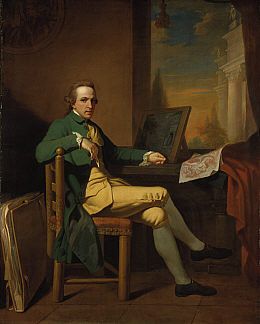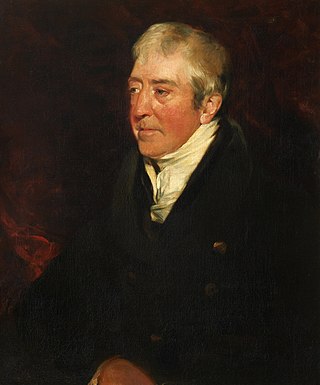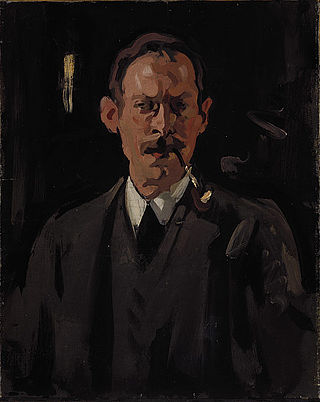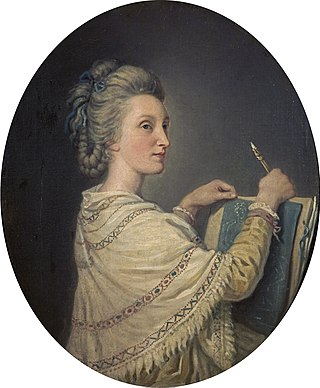Related Research Articles

David Allan was a Scottish painter, limner, and illustrator, best known for historical subjects and genre works.

Sir Henry Raeburn was a Scottish portrait painter. He served as Portrait Painter to King George IV in Scotland.

Allan Ramsay was a prominent Scottish portrait-painter.

Alexander Nasmyth was a Scottish portrait and landscape painter, a pupil of Allan Ramsay. He also undertook several architectural commissions.

The Scottish Colourists were a group of four painters, three from Edinburgh, whose Post-Impressionist work, though not universally recognised initially, came to have a formative influence on contemporary Scottish art and culture. The four artists, Francis Cadell, John Duncan Fergusson, Leslie Hunter and Samuel Peploe, were prolific painters spanning the turn of the twentieth century until the beginnings of World War II. While now banded as one group with a collective achievement and a common sense of British identity, it is a misnomer to believe their artwork or their painterly careers were heterogeneous.

Dame Elizabeth Violet Blackadder, Mrs Houston, was a Scottish painter and printmaker. She was the first woman to be elected to both the Royal Scottish Academy and the Royal Academy.

John Duncan Fergusson was a Scottish artist and sculptor, regarded as one of the major artists of the Scottish Colourists school of painting.

Samuel John Peploe was a Scottish Post-Impressionist painter, noted for his still life works and for being one of the group of four painters that became known as the Scottish Colourists. The other colourists were John Duncan Fergusson, Francis Cadell and Leslie Hunter.
Alison Watt OBE FRSE RSA is a British painter who first came to national attention while still at college when she won the 1987 Portrait Award at the National Portrait Gallery in London.

The Monarch of the Glen is an oil-on-canvas painting of a red deer stag completed in 1851 by the English painter Sir Edwin Landseer. It was commissioned as part of a series of three panels to hang in the Palace of Westminster, in London. As one of the most popular paintings throughout the 19th century, it sold widely in reproductions in steel engraving, and was finally bought by companies to use in advertising. The painting had become something of a cliché by the mid-20th century, as "the ultimate biscuit tin image of Scotland: a bulky stag set against the violet hills and watery skies of an isolated wilderness", according to the Sunday Herald.

Joan Kathleen Harding Eardley was a British artist noted for her portraiture of street children in Glasgow and for her landscapes of the fishing village of Catterline and surroundings on the North-East coast of Scotland. One of Scotland's most enduringly popular artists, her career was cut short by breast cancer. Her artistic career had three distinct phases. The first was from 1940 when she enrolled at the Glasgow School of Art through to 1949 when she had a successful exhibition of paintings created while travelling in Italy. From 1950 to 1957, Eardley's work focused on the city of Glasgow and in particular the slum area of Townhead. In the late 1950s, while still living in Glasgow, she spent much time in Catterline before moving there permanently in 1961. During the last years of her life, seascapes and landscapes painted in and around Catterline dominated her output.


Mary Margaret Cameron was a Scottish artist, renowned for her depictions of everyday Spanish life. She exhibited 54 works at the Royal Scottish Academy between 1886 and 1919.
John Duncan Macmillan is a Scottish art historian, art critic, and writer.

Kate Whiteford OBE is a Scottish artist. Her work includes painting, screen prints, textiles, land art and installations.

Anne Forbes (1745–1834) was a Scottish portrait painter, educated in Rome, who worked in London and later in Edinburgh, where she was Portrait Painter to the Society of Antiquaries of Scotland. Although her career in London was cut short by illness, she was one of the first Scottish women artists to make a career from painting, and according to Colin Russell "her importance remains in her struggle against gender prejudice".

Adam Bruce Thomson OBE, RSA, PRSW or ‘Adam B’ as he was often called at Edinburgh College of Art, was a painter perhaps best known for his oil and water colour landscape paintings, particularly of the Highlands and Edinburgh. He is regarded as one of the Edinburgh School of artists.

Beatrice Huntington (1889–1988) was a Scottish artist, sculptor and musician exhibiting regularly at the Royal Academy, Royal Scottish Academy and the Royal Glasgow Institute. A natural colourist, she is most celebrated as a portrait painter.
Archie Brennan (1931–2019) was a noted Scottish tapestry weaver. He served his apprenticeship at the Edinburgh Tapestry Co and studied at Edinburgh College of Art. He went on to work at the College establishing their department of Tapestry and Fibre Arts. He also served Dovecot as their artistic director.

Janet (Jenny) Armstrong was a shepherd who became the focus of the Scottish artist Victoria Crowe's work. After she retired, she continued to keep a small flock, and this was when Crowe moved next door and they became friends. Between 1970 and 1985, Crowe produced more than 50 paintings and drawings of Armstrong's retirement years, showing her journey through the final 15 years of life. Crowe's paintings and drawings were put on view at an exhibition entitled A Shepherd's Life at the Scottish National Portrait Gallery in 2000 which attracted more than 30,000 visitors.
References
- ↑ Victoria Crowe. 50 Years: Drawing & Thinking. The Scottish Gallery. 2019. ISBN 978-1-912-900-08-4.
- 1 2 Victoria Crowe. 50 Years: Drawing & Thinking. The Scottish Gallery. 2019. pp. 147–9. ISBN 978-1-912-900-08-4.
- 1 2 3 4 5 "Victoria Crowe interview: Shepherd's delight". The Scotsman. 14 January 2009. Retrieved 18 February 2014.
- 1 2 3 4 5 6 Victoria Crowe ARSA RSW. London: Thackeray Gallery. 1994.
- 1 2 Mansfield, Susan (Journalist) (2019). Victoria Crowe : 50 years of painting. Crowe, Victoria., Macmillan, Duncan, 1939-, Peploe, Guy., Edinburgh City Art Centre. Bristol. ISBN 978-1911408468. OCLC 1063698332.
- 1 2 Lawson, Julie (20 October 2012). "Book review: Victoria Crowe by Duncan Macmillan". The Scotsman. Retrieved 18 February 2014.
- ↑ "Prof Peter Higgs: New portrait of boson particle physicist". 15 June 2013. Retrieved 18 February 2014.
- ↑ "The Full List". The Glasgow Herald. 12 June 2004. Retrieved 18 February 2014.
- ↑ "Current Fellows by Academic Discipline Groups" (PDF). Royal Society of Edinburgh. Retrieved 18 February 2014.
- ↑ "Full list of RSA Members". Royal Scottish Academy. Retrieved 18 February 2014.
- ↑ "Plant Memory". Royal Scottish Academy. Retrieved 18 February 2014.
- ↑ "Victoria Crowe: Beyond Likeness" . Retrieved 14 May 2018.
- ↑ "Callum Macdonald, 1912 – 1999. Printer and publisher". National Galleries of Scotland. Retrieved 18 February 2014.
- ↑ "Graham Crowden, 1922 – 2010. Actor". National Galleries of Scotland. Retrieved 18 February 2014.
- ↑ "Dr Winifred Rushforth, 1885 – 1983. Psycho-analyst". National Galleries of Scotland. Retrieved 18 February 2014.
- ↑ "Victoria Crowe". National Portrait Gallery (London). Retrieved 18 February 2014.
- ↑ "Into an Older Land by Victoria Crowe". Art UK . Retrieved 18 February 2014.
- ↑ Victoria Crowe. 50 Years: Drawing & Thinking. The Scottish Gallery. 2019. pp. 147–9. ISBN 978-1-912-900-08-4.
- ↑ Victoria Crowe: Painted Insights. Antique Collectors' Club. 2001. ISBN 978-1851495894.
- ↑ Taylor, Alan (20 July 2012). "Duncan Macmillan: Victoria Crowe (Antique Collectors' Club, £35)". The Glasgow Herald. Retrieved 18 February 2014.
- ↑ Mansfield, Macmillan, Peploe (2019). Victoria Crowe: 50 Years of Painting. Sansom & Co. ISBN 978-1-911408-46-8.
{{cite book}}: CS1 maint: multiple names: authors list (link)